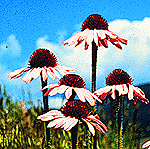|
|
The Eclectic Physician
Medicinal Herb Monographs
Purple Coneflower/Echinacea
Botanical Name
Echinacea purpurea
Echinacea angustifolia
|

Echinacea
(Purple Cone Flower)
|
The information on this page compiled by
Beth Burch N.D.
Index
(click on the keywords)
Introduction
Echinacea species have a long history of use by native Americans as an
antiseptic, analgesic and snake bite remedy. The two main species used
are purpurea and angustifolia, pallida is also used. The Eclectic physicians
introduced Echinacea into American medicine in 1885 as a blood purifier.
It was found to be very effective for abscesses, indolent ulcers, and sepsis.
Echinacea has been extensively studied in Europe, demonstrating anti-viral,
immune modulation and wound healing effects.
[ Back to the Index. ]
Description
-
A member of the compositae family, Echinacea is perennial herb native to
Midwestern North America, from Saskatchewan to Texas. It has a beautiful
pink-purple daisy like flower with a center cone, hence its common name,
purple cone flower. Echinacea purpurea is an easily cultivated plant and
has such lovely flowers making it a welcome addition to the flower garden.
All parts of the Echinacea plant are used including flowers, leaves, stems,
roots and seeds.
[ Back to the Index. ]
Constituents
-
Polysaccharides
-
Inulin
-
Flavonoids- in leaves and stems
-
Alkamides
-
Caffeic acid derivatives
-
Glyco-proteins- in roots
-
Polyynes- in roots
-
Volatile oils
[ Back to the Index. ]
Action/Effects
-
Immune modulation
-
Anti viral
-
Antibacterial
-
Anti-inflammatory
-
Inhibits hyaluronidase
-
Promotes would healing
[ Back to the Index. ]
Conditions used
for
-
Impaired immune system function such as recurrent colds and flu and recurrent
ear infections (1, 2)
-
Viral infections, especially colds, influenza and herpes (3,4,5,6)
-
Recurrent yeast infections (7)
-
Bacterial infections (8)
-
Wounds and abscesses (8)
-
Inflammation (8)
[ Back to the Index. ]
Dosage
-
For acute conditions-
-
Liquid extract- 1 teaspoon every 3-4 hours
-
Dry extract (10:1)-125 mg every 3-4 hours
-
Dry - 500 mg every 3-4 hours
-
For chronic infections/impaired immune function-
-
Liquid extract- 1/2-1 teaspoon 1-3 times a day
-
Dry extract (10:1) 75-125 mg 1-3 times a day
-
Dry- 250-500 mg 1-3 times a day
-
For wounds-
-
Apply compresses soaked with extract to the wound every 2-6 hours
-
Take internally as for acute infections
-
Childrenís dosage- Multiply adult dosage times the childís weight, then
divide by 150.
[ Back to the Index. ]
Side Effects
None known
Virtually non-toxic (9)
[ Back to the Index. ]
Contraindications
-
Autoimmune diseases
-
Progressive diseases like tuberculosis, multiple sclerosis, AIDS, leukoses,
collagenoses
-
Psoriasis
-
Allergy to flowers of the daisy family (10)
[ Back to the Index. ]
Interactions
with medications
-
Donít use with hepatotoxic medications like anabolic steroids, methotrexate
and ketoconazole
-
May decrease the action of immunosuppressants like corticosteroids and
cyclosporin (11)
[ Back to the Index. ]
Use in
pregnancy & lactation
-
Safe for use in pregnancy and lactation
[ Back to the Index. ]
References
1. Rehman J, et al, Increased production of antigen-specific
immunoglobulins G & M following in vivo treatment with the medicinal
plants Echinacea angustifolia and Hydrastis canadensis, Immunol Lett, 1999;68(2-3):391-5
2. Erhard M et al, Effect of Echinacea.....on Phagocytosis of Human
Granulocytes, Phytother Res 1994;8:14-7
3. Brinkeborn RM et al, Echinoforce and other Echinacea fresh plant
preparations in th treatment of the common cold, Phytomedicine 1999;6(1):1-6
4. Schoenberger D, The influence of immune-stimulating effects of pressed
juice from Echinacea purpurea on the course and severity of colds, Forum
Immunol 1992;8:2-12
5. Wacker A et al, Virus inhibition by Echinacea purpurea, Planta Medica
1978;33:89-102
6. Braunig R et al, Echinacea purpurea root for strengthening the immune
response in flu-like infections, Z Phytother 1992;13:7-13
7. Coeugniet E et al, Recurrent candidiasis: adjuvant immunotherapy
with different formulations of Echinacin, Therapiewoche 1986;36:3352-58
8. PDR for Herbal Medicines, Medical Economics Co, NJ, 1998: 818-19
9. Mengs U, Toxicity of Echinacea purpurea, Arzneimittelforschung 1991;41(10):1076-81
10. Mullins RJ, Echinacea-associated anaphylaxis, Med J Aust 1998;168(4):170-1
11. Miller LG, Herbal medicinals: selected clinical considerations
focusing on known or potential drug-herb interactions, Arch Intern Med
1998;158(20):2200-11
[ Back to the Index. ]
* The information presented in this web site is intended to inform and educate.
It is not intended replace a qualified medical practitioner to diagnose or treat medical conditions.
|
|

